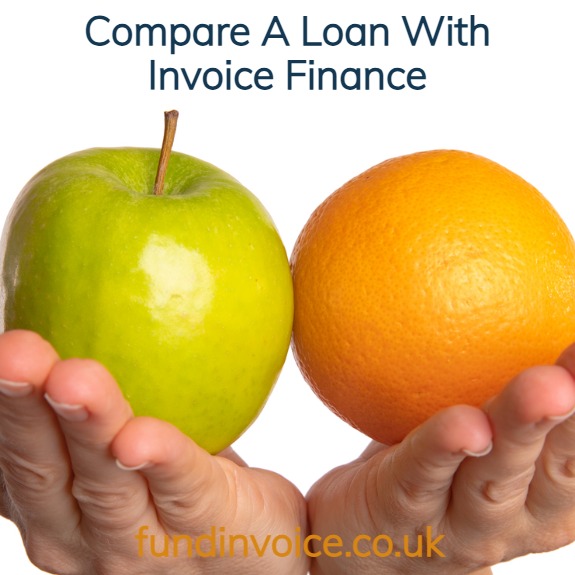- 29 Jul
Compare A Loan With Invoice Finance
Something a little bit different, I wanted to compare a loan with invoice finance by comparing the amount of cash made available to the borrower over time.
This demonstrates something about the nature of these two products that is often overlooked and could be very much to the borrower's detriment. Whereas the capital amount from the loan gradually reduces, in the right circumstances, the funding from invoice finance can remain at the initial level or even grow if turnover increases.
Compare A Loan With Invoice Finance
 The idea for this comparison came about when an existing client suggested that they wanted to move from invoice financing to a loan, as they thought it would be cheaper. As it happens, there would likely be very little difference in the cost, but there will be a very large difference in the medium-term cash flow impact, something that they had overlooked.
The idea for this comparison came about when an existing client suggested that they wanted to move from invoice financing to a loan, as they thought it would be cheaper. As it happens, there would likely be very little difference in the cost, but there will be a very large difference in the medium-term cash flow impact, something that they had overlooked.Also, there may be additional security requirements for a loan of several hundred thousand pounds. For instance, there may be a requirement for security over property, which is very unlikely with invoice financing.
Capital Repayments
It is this issue of capital repayments that is often completely overlooked. With a commercial loan, the borrower normally repays both interest and part of the capital over time (normally each month). This means the amount of funding left in your business slowly decreases.
Invoice financing is what we call a revolving facility. If your monthly volume of trade remains stable, the amount of funding remains constant. This is because, as invoices are paid by customers, funding is repaid, and as new invoices are raised, funding is released.
This revolution of the capital is why it is referred to as a revolving facility.
Comparing A Business Loan With Invoice Financing
To make the comparison, we need to look at the fees and the amount of cash released to the company. This comparison deals with a term loan (repaid over its term in regular payments). The alternative loan type would be a revolving business loan that does allow the facility to be partially drawn, repaid and then redrawn.
Comparing The Fees
The difference in fees is likely to be minimal in this case.
Therefore, I disregarded fees for the purpose of building the model to compare funding levels between invoice finance and a business loan.
Comparing The Funding
I have built a simple spreadsheet that compares the funding released by an invoice finance facility and a business loan: Comparison of Finance From A Loan with Invoice Finance
What is shown in our example is as follows:
- After the first month, the finance from invoice finance is already £4,250 more than from the loan, as the first capital repayment has been made on the commercial loan.
- After the first year, the finance from the loan (due to the monthly repayments) is now £51K less than from the invoice financing.
- After the second year, the finance from the loan is now £102K less than the invoice finance.
- After the third year the full capital sum from the loan, £153K has been fully repaid but that amount is still being funded from the invoice financing.
Assumptions used in the model:
- The company's turnover is static. If it were to grow, more funding would be released from invoice finance, yet the term loan would release the same initial amount of finance.
- Customer repayments are regular. The company receives monthly payments from customers that equal its new monthly invoicing.
- The loan is for the same amount of finance that is released on day one from the invoice financing facility.
- Equal monthly loan repayment over a 36-month (3-year term) - fees are not included in the model for either facility, as they were assumed to be similar.
What About Overdraft?
The availability of overdrafts has been less of late, and the likelihood of getting one of sufficient size is very low in this case.
Summary Of The Comparison Between Business Loans And Invoice Finance
The model shows that the amount of funding over time is significantly higher from invoice financing (using the assumptions explained above) when compared with a commercial term loan. Of course, the company will be paying the fees to the invoice financier for that funding, but the impact on their cash flow will be significant. In effect, the initial amount of funding remains throughout the whole period (based on those assumptions), whereas the loan is gradually repaid over the term.
- Home
- Business Financing
- Invoice Finance
- Invoice Discounting
- Factoring
- Debt Factoring
- Recourse Factoring
- Fund Selected Invoices
- Business Loans
- Construction Sector Funding
- Protect Against Bad Debts
- Exports Collection And Funding
- Import Funding
- Body Shop Funding
- Spot Factoring
- Retail Sector Funding
- Fund Invoices Confidentially
- Help Running Your Payroll
- CHOCs Customer Handles Own Collections
- Collect Invoices Confidentially And Funding
- Outsourcing Your Credit Control
- Asset Finance And Mortgages
- Case Studies
- About Us
- Testimonials
- Find Out More
- News
- Free Magazine
- Blog






